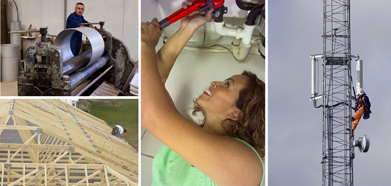Module 4
1. Module 4
Module 4 Introduction

sheet metal: Hemera /Thinkstock; roofer: Hemera Technologies/Thinkstock; plumber: Brand X Pictures/Thinkstock; tower: Brand X Pictures/Thinkstock;
What do a plumber, a carpenter, an electrician, and a metalworker have in common? All of these tradespeople use mathematics in their work. If you asked, you would discover that the mathematics of the right triangle is a common element for all of these workers. As you work through this module, you will investigate applications of the Pythagorean theorem, similar right triangles, and right-triangle trigonometry in the trades. If you are interested in a career in the trades, take some time to find out what mathematics will be central in your training.
One of your tasks for the Module 4 Project: The Right Triangle—At Work and at Play is to interview a tradesperson or do some research to discover the aspects of right-triangle mathematics used in the trades. The module project will also look at how triangle math is found and used in puzzles, games, and each day in the workforce.
Studying mathematics is not just preparation for work—mathematics is entertainment! If you think this statement is puzzling, work through Module 4 for the answer. Looking at various puzzles and games might make you think about triangles. These geometric figures play an important part in the design or play of each puzzle. As you work through this module, you will investigate the Pythagorean theorem, similar right triangles, and trigonometry. You will see how these math elements are applied in puzzles, games, work, and everyday life.
Attempt the puzzles in “Pythagorean Puzzles.” Here are some notes before you begin:
- There are four red triangles and one blue square for each white region.
- The triangles and squares can be rotated by putting the cursor hand over a corner (do not click!) and waiting for a solid circle to appear. When the circle appears, you are able to click and drag to rotate the shapes.

© 1999-2010 Utah State University. All Rights Reserved.